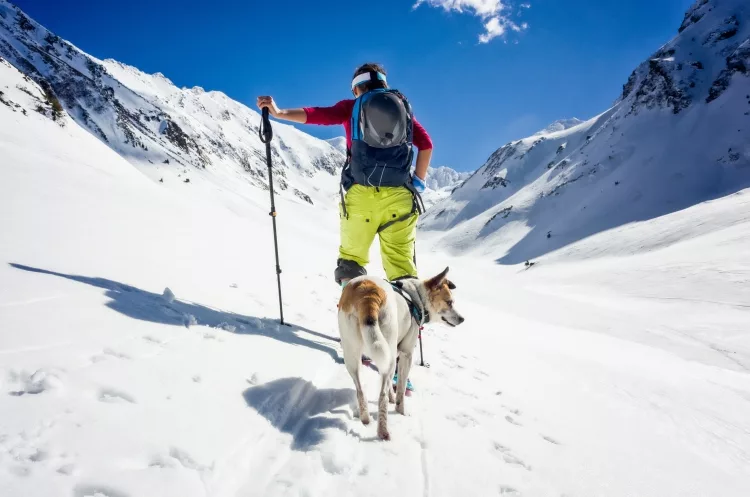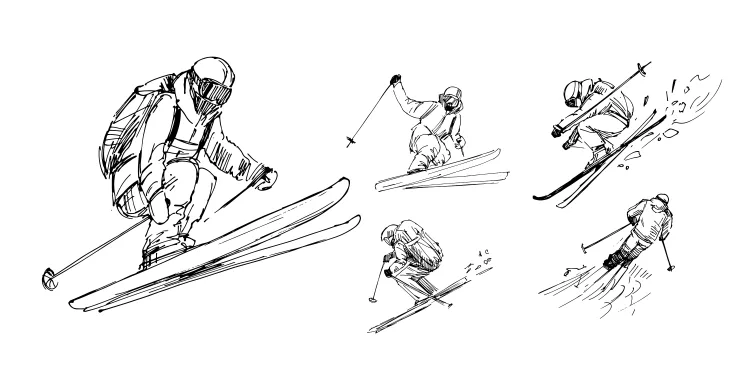Ski Mountaineering is an adventure sports activity which is a combination of skiing and mountaineering. Although, this sounds pretty obvious, but the main point to note in ski mountaineering is the fact that mountaineering can be done while climbing up a steep slope, by wearing skis, or by holding the skis in hand. Once the skier reaches the point of launch, then a descent is made wearing skis. Like any other adventure sport, ski mountaineering also has its do’s and don’ts, along with its specialised equipment. Enough care must be taken while choosing the right gear for ski mountaineering, as any incorrect choice can prove disastrous, especially in areas which are remote from urban population. Beginners need to take great care before venturing out for snow mountaineering, as it is an activity which is fraught with dangers to the uninitiated. Let us first have a look at some of the important tips for beginners in ski mountaineering.
Contents


For beginners in ski mountaineering, it is essential to take professional guidance before embarking on a highly adventurous journey. Guidance is a must regarding the kind of equipment that needs to be bought for ski mountaineering. This type of guidance is easily available from the ski mountaineering schools of the region, who also have the facility to give out rentals of ski equipment. They also provide the options of hiring an experienced guide for a beginner’s first step on the snow.
Equipment required for ski mountaineering includes the right kind of mountaineering boots, the correct type of skis, ski poles that can be adjusted as per needs, and also a shovel to remove snow along the way. For communications, a transceiver is a must to have, as well as a probe which helps to find the type of path ahead. A headlamp is also essential, as one never knows when someone may need some light in mountains when it gets cloudy a bit late in the evening. To perform any repairs, it is important to have a repair kit handy. Just in case, one falls sick, or any of the team members gets hurt while climbing or during the descent, a medical kit is a big help to have. If one has all these equipment and also knows how to use them and at what times, then a beginner has cleared the first step in being ready for ski mountaineering.
It is important for a beginner to actually enrol themselves in a ski mountaineering class if they truly wish to go out there and enjoy the full benefits that this adventure sport has to offer. Each and every place has their own ski mountaineering institute, and the main criteria that need to be seen before enrolment are if the institute is affiliated with any professional body, if the instructors are well knowledgeable and reputed, what kind of facilities the institute provides, and how have the experiences of the persons been who have previously signed up for courses in the institute.
Experienced institutes not only provide a beginner with the essential knowledge about ski mountaineering but impart the knowledge in a very systematic way. Aspects of skiing and mountaineering are clearly bifurcated, and students are made aware of the skills and equipment required for both these activities. It is also a point to note that if a person is not comfortable with skiing so much, then it is best to bring that to the surface, in the beginning, itself, rather than facing the fact when out there on the top of a mountain!
Ski mountaineering is a very physically intensive activity, like most of the adventure sports. It is essential that a beginner looking to pursue this activity seriously must shore up their levels of endurance to higher levels, which keeps a person fit and running for the full length. Trial runs need to be undertaken in the sense that before embarking on an actual journey, a beginner should find ways to climb mountains, especially in the offseason. Once someone starts climbing almost two to three thousand feet along with an incline, then they can better understand what their power of endurance is.
In the beginning, a person may find that they need breaks more often, and also that their legs and feet hurt after a few minutes of climbing. If this happens then it also shows that a person is doing it right. Gradually as the stamina goes on to increase, it will be found that the duration of breaks slacken, and a person is also able to do more than one trial run in a single day. Such a strong preparation time is very much needed o actually start ski mountaineering before the season sets in. Relevant knowledge about food that is helpful in increasing stamina levels, and what type of food is suitable to be carried along while going for ski mountaineering, is a must.
One of the major causes of ski mountaineering accidents across the world is avalanches. There is no way to absolutely predict avalanches, and there can only be indications about it. The experts of ski mountaineers are those who have successfully avoided avalanches, or have avoided getting hurt from them. Getting caught up in an avalanche can not only be a nightmare, but fatal. Either it may kill a mountaineer directly, or it may cause a fall which can result in a serious handicap or fatality. So, it is important for anyone to have a proper awareness of avalanche prospects in an area before embarking on a ski mountaineering trip.
Before a person starts to think that by climbing just one kind of terrain that they are comfortable with in their backyard, they have started to become experts in ski mountaineering, it is important to first test abilities on various kinds of terrains. Some terrains are more technical than the others and require a change in gear as well. It is very much possible to encounter terrains which involve a higher usage rate of equipment such as pick axes while carefully climbing up steep slopes. In some terrains the types of rocks found are different, and this calls for a careful analysis of the conditions and potential pitfalls with the help of guides or experienced professionals. Some terrains can be with glaciers, and some with areas without any crevasses, which do not have much danger of any failing bridges etc.
The body posture not be too bent along the waist while climbing the steeps, and should be as upright as possible. For best results while climbing up, it is essential to feel relaxed and also keep the body relaxed. While wearing skis, it is important that the positioning of the feet should be right in the centre of the skis, and the entire leg should be used to move the ski forward, and not just the foot and the knee.
In any adventure sport, it is quite usual to expect something out of the ordinary. Ski mountaineering is another such sport, where a mountaineer can get stuck, or be delayed as per the usual timelines and so on. Also, mountain environments are generally very challenging, and a high degree of alertness and awareness is required in case of avalanches. Also, mountaineers need to be aware of the crevasses and their types, and also need to have the relevant knowledge on what to do in case of a fall. Thus, it is very important to inform someone before going for ski mountaineering, especially when one is a beginner. It is also highly advisable to take someone more experienced along as a guide.
Beginners also have a few other points to keep in mind before going out for ski mountaineering. If someone does not have a good skiing experience but has a decent mountain climbing experience, then there is a chance of frustration in the attempts to ski down the slope after climbing up the mountain. It is always advisable to actually go for skiing classes, brush up the knowledge related to skiing gear and have some hands on pilot runs. Also, it is important to have skills related to the assessment of glaciers, as many ski mountaineering trips involve glacier skiing as well.
Essential knowledge related to procedures required for travel along the glaciers is also a must for skiers. If these steps are absent, then there is always a danger that the skier may tend to fall into a crevasse. In the event of that happening, a skier must also be aware of the rescue steps required from a crevasse fall. Thus, all in all, a well-rounded knowledge and guidance is required before a beginner can ctually go out there into the wild, and start ski mountaineering on his own.
 |
 |
 |
 |
Recent Post
Try the new FREE GiveAways Page
Something wrong ? Try refresh this page
Whitelist, remove adblock to see all the secrets. Once done, hit refresh button below.
 |
 |
 |
 |